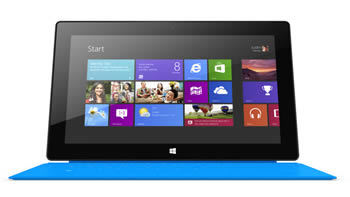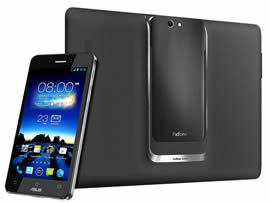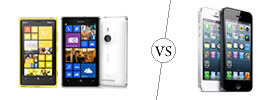Difference between Microsoft Surface RT and Asus Padfone Infinity
Key Difference: The Microsoft Surface RT is a tablet that features a 10.6-inch TFT HD capacitive touchscreen with approximately 148 ppi density. The screen affords the true 16:9 aspect ratio. However, the OS is not compatible with old Windows PC programs. The Asus Padfone Infinity smartphone is a slick 5-inch full HD 1920x1080, Super IPS+ with Capacitive Multi touch panel and provides approximately 441 ppi density. The device is a bar phone, with curved corners giving it a similar look to the ‘iPhone’ and ‘HTC One’. The Asus Padfone Infinity Dock is basically the 10-inch tablet shell that allows users to dock their phone into the tablet by sliding it into a slick slot on the back.
 The market for bigger, better and more able smartphones is increasing. People are getting bored with the regular phones that would just place calls or send text message, now the phones need to be able to do many other things to even be considered as a choice. The phone should allow the users to surf the internet, check e-mails, record their schedules, find things on the internet, understand their speech, etc. They have become less phones and more personal secretaries. Now, it goes even further and tablets have come into the picture. Tablets have the portability of a phone and the functions of a laptop. Some tablets even allow users to place calls. Microsoft, which was originally a Desktop manufacturer, has now shifted focus on creating smartphone operating systems, laptops, and even tablets. The Microsoft Surface RT was launched in November 2012.
The market for bigger, better and more able smartphones is increasing. People are getting bored with the regular phones that would just place calls or send text message, now the phones need to be able to do many other things to even be considered as a choice. The phone should allow the users to surf the internet, check e-mails, record their schedules, find things on the internet, understand their speech, etc. They have become less phones and more personal secretaries. Now, it goes even further and tablets have come into the picture. Tablets have the portability of a phone and the functions of a laptop. Some tablets even allow users to place calls. Microsoft, which was originally a Desktop manufacturer, has now shifted focus on creating smartphone operating systems, laptops, and even tablets. The Microsoft Surface RT was launched in November 2012.
The Microsoft Surface RT is a tablet that features a 10.6-inch TFT HD capacitive touchscreen with approximately 148 ppi density. The screen is pretty decent in terms of resolution and shows clear, sharp images. The screen affords the true 16:9 aspect ratio which matches most movies and shows, eliminating the black bars that pop up. The tablet runs on the Windows OS, but has a huge lacking feature. The OS is not compatible with old Windows PC programs such as VLC, Photoshop Elements, etc. This is one of the reasons for the tablet not being so popular even after the amazing design and other attractive features. In order to run the old PC programs, one would require Windows 8 with an Intel processor, which is offered in the Microsoft Surface Pro.
The device has a slab form that makes it look thicker and heavier than it actually is. The device is only 9.4 mm thick, same as the iPad; however, the slab form that has not been tapered towards the end makes it seem thicker. The tablet is a little heavier compared to other devices because of the extra inches on the screen. The device is quite slick, which makes it easier to grip but more prone to slipping through the fingers. The device comes with a built-in kickstand that helps it stay upright when placed on a surface. The device is covered in a VaporMg casing, which according to the company, makes the device scratch and water-resistant. The device also has an intriguing feature, which is a cover that doubles as a keyboard. The sleek and flat keyboard has an aesthetic appeal and is also productive.
On top of the device when facing front in landscape mode, there is an ambient light sensor along with the front facing 1.2 MP camera. On the bottom bezel is the Windows Home sensor that takes the user to the start screen or the last app accessed. On the right side of the device, there is a speaker grille, a Micro-HDMI port, a full USB 2.0 port, and the power port. The left side has an additional speaker grille, a headphone jack, and a volume rocker. The kickstand is said to be a bit difficult for some people, while other claim that the stand was pretty smooth and easy to access. Under the stand, resides the microSD port, while there are magnets on the bottom to attach the Touch and Type keyboard covers. The device also has a 1.2 MP rear camera, in case anyone would like use it take photos.
The tablet is powered by a 1.3 GHz Quad-core Cortex-A9 and comes in 32 and 64 GBs variants. The device feature 2 GB RAM. The processor provides enough power to allow the swiftly shifting between apps and windows. The tablet supports 802.11 a/b/g/n Wi-Fi support, Bluetooth 4.0, a gyroscope, an accelerometer, and a built-in compass, but no GPS. The device houses a 31.5 W-h battery that drained pretty quickly according to CNET. The main problem that comes with this device is that it is less of a tablet and more of an even more portable laptop. The design is obviously appealing, but in terms of features and price, maybe going for Microsoft Surface Pro.
 Asus has announced its latest phone and tablet in the Padfone series, knighted the Asus Padfone Infinity. The original Asus Padfone did not reach the Western Shores but the company states that the Padfone Infinity is set for world-wide launch in the second quarter of 2013. Similar to the original Padfone, the Padfone Infinity is available just as smartphone or along with a tablet dock that allows seamless transition between phone and tablet needs. The Padfone Infinity is a pretty intriguing concept that allows the phone to dock on the tablet, which powers the tablet and transfers all the data on the tablet for use. However, without the phone the tablet is just a shell without any ‘brain’ of its own. The phone/tablet is set to provide serious competition to rivals Sony Xperia Z Tab, iPad 4 and Samsung Galaxy Tab. Let’s cover its features separately.
Asus has announced its latest phone and tablet in the Padfone series, knighted the Asus Padfone Infinity. The original Asus Padfone did not reach the Western Shores but the company states that the Padfone Infinity is set for world-wide launch in the second quarter of 2013. Similar to the original Padfone, the Padfone Infinity is available just as smartphone or along with a tablet dock that allows seamless transition between phone and tablet needs. The Padfone Infinity is a pretty intriguing concept that allows the phone to dock on the tablet, which powers the tablet and transfers all the data on the tablet for use. However, without the phone the tablet is just a shell without any ‘brain’ of its own. The phone/tablet is set to provide serious competition to rivals Sony Xperia Z Tab, iPad 4 and Samsung Galaxy Tab. Let’s cover its features separately.
The Asus Padfone Infinity smartphone is a slick 5-inch full HD 1920x1080, Super IPS+ with Capacitive Multi touch panel and provides approximately 441 ppi density, making the screen visibly sharp, crisp and clear. The device is a bar phone, with curved corners giving it a similar look to the ‘iPhone’ and ‘HTC One’. The phone has a sleek metallic chassis, with a silver brushed look on the back. The phone is powered by the latest 1.7GHz quad-core Krait Qualcomm Snapdragon 600, providing fast responsiveness from the device. It offers the latest Android v4.2 Jelly Bean. The phone has a 2GB RAM and is available with 32/64 GB of internal storage capacity. The phone houses a 13MP primary camera and a 2MP secondary camera, with HD recording capability. The massive battery power allows the phone to provide up to 19 hours of 3G talk time. The company also introduced a bunch of new features such as Asus Echo, SuperNote, ASUS Story, Instant Dictionary and two years’ free Cloud Storage with 50GB ASUS WebStorage. The Asus Echo is the newest personal assistant, similar to Siri that allows the user to activate a number of features (search contacts, make calls, pick up incoming calls, activate the camera shutter for self-portraits, set alarms, change settings, etc) on the phone using voice commands. The new SuperNote supports real-time handwriting to text conversion and is sensitive enough to accurately translate from handwriting to text. Asus Story allows users to create albums and story lines, while Instant Dictionary allows users to translate words, phrases and sentences in emails, web pages or apps.
The Asus Padfone Infinity Dock is basically the tablet shell that allows users to dock their phone into the tablet by sliding it into a slick slot on the back. The slot comes with rubber gromits that ensures that the phone locks into place and does not slide out and fall. When the phone is docked on the tablet, the tablet and the phone synchronize automatically and the apps that were on the screen of the phone automatically re-sizes itself and pops up on the tablet screen. The tablet sports a 10.1 Full HD 1920x1080, Super IPS+ with Capacitive Multi touch panel, similar to the phone, providing a clear and detailed picture on the tablet. The screen on both, the phone and the tablet, have a Corning Gorilla Glass covering. The tablet does not have a processor or anything such hardware on it. It does offer a few advantages to the phone. The tablet houses a 1MP front camera for video calls. The tablet is also capable to output 1080 Full HD video via Micro-USB compatible MyDP interface. The device also has a dialer and is able to accept and make phone calls and send text messages. The phone and the tablet have speakers have the ASUS Audio Wizard audio enhancement providing rich audio experience. The battery as a massive 5000 mAh Li-Polymer, that enhances the battery power of the phone allowing up to 40 hours of 3G talk time. The tablet also has the power to charge the phone three times with a full battery. The tablet starts charging the battery of the phone, when the phone is docked into the tablet.
The high-end phone/tablet hybrid comes with a high-end price of EUR 999 and should be around US$ 1300 when it finally reaches the States. The main purpose of such a hybrid is so that people can use one data plan and it eliminates the need for manually synchronizing the tablet to phone and vice-versa. The phone has also been criticized for the lack of the keyboard, which was one of the features available in the original Padfone. Will the phone be a massive success or failure will be seen when the phone finally becomes available world-wide.
The information for the detailed table about the two devices has been taken from the Microsoft website, Asus website and GSMArena.com.
|
|
Microsoft Surface RT |
Asus Padfone Infinity |
|
Launch Date |
November 2012 |
Expected Release Q2/2013 |
|
Company |
Microsoft |
Asus |
|
Size |
274.6 x 172 x 9.4 mm |
Phone:143.5 x 72.8 x 8.9 mm Pad: 264.6 x 181.6 x 10.6 mm |
|
Display |
10.6 inches TFT HD capacitive touchscreen |
Phone: 5-inches, Full HD 1920x1080, Super IPS+ with Capacitive Multi touch panel Pad: 10.1-inches, Full HD 1920x1080, Super IPS+ with Capacitive Multi touch panel |
|
Screen |
1366 x 768 pixels (~148 ppi pixel density) 16M colors |
Phone: 1080 x 1920 pixels (~441 ppi pixel density) Pad: 1920x1080 pixels (~441 ppi pixel density) |
|
Protection |
VaporMg casing |
Corning Gorilla Glass on both the phone and the pad. |
|
Weight |
680.4 grams |
Phone: 141 grams Pad: 530 grams |
|
2G Network |
N/A |
GSM 850 / 900 / 1800 / 1900 |
|
3G Network |
N/A |
HSDPA 900 / 2100 |
|
4G Network |
N/A |
LTE 800 / 1800 / 2600 / 2100 |
|
GUI |
Windows RT |
Asus' UI |
|
CPU speed |
1.3 GHz Quad-core Cortex-A9 |
1.7GHz quad-core Krait Qualcomm Snapdragon 600 |
|
GPU |
ULP GeForce |
Adreno 320 |
|
OS |
Windows RT |
Android v4.2 (Jelly Bean) |
|
Chipset |
Nvidia Tegra 3 T30 |
Qualcomm APQ8064T Snapdragon 600 |
|
RAM |
2 GB |
2 GB |
|
SIM Size |
N/A |
nanoSIM |
|
Internal Memory |
32/64 GB |
32/64 GB |
|
Expandable Memory |
Up to 64 GB |
N/A |
|
Sensors |
Accelerometer, Gyro, Compass, Ambient light sensor |
G-Sensor, E-compass, Gyroscope, Proximity, Light Sensor |
|
Connectivity |
Wi-Fi, Wi-Fi direct, Bluetooth, USB. |
GPRS Class 10, EDGE Class 10, LTE, Bluetooth, Wi-Fi, USB, Wi-Fi hotspot. |
|
Data |
WLAN, Bluetooth, USB. |
GPRS, EDGE, WLAN, Bluetooth, NFC, USB, USB Host. |
|
Speed |
- |
DC-HSPA+, 42 Mbps; HSDPA, 21 Mbps; HSUPA, 5.76 Mbps; LTE, Cat3, 50 Mbps UL, 100 Mbps DL |
|
WLAN |
Wi-Fi (802.11a/b/g/n) Wi-Fi Direct, dual-band |
Wi-Fi 802.11 a/ac/b/g/n, Wi-Fi Direct, dual-band, Wi-Fi hotspot |
|
Bluetooth |
Bluetooth v4.0 with A2DP |
Bluetooth v4.0 with A2DP |
|
USB |
USB v2.0, USB Host support |
microUSB v2.0 (MHL), USB Host |
|
Primary Camera |
1.2 MP |
13 MP, 4128 x 3096 pixels, autofocus camera |
|
Secondary Camera |
1.2 MP |
Phone: 2 MP 1080p@30fps camera Pad: 1MP front camera |
|
Video |
720p @ 30fps |
1080p@30fps |
|
Camera Features |
Geo-tagging |
LED flash Geo-tagging Touch focus Face detection |
|
Sound Enhancement |
Two microphones, Stereo speakers |
ASUS Audio Wizard ASUS Sonicmaster |
|
Audio supported formats |
MP3/ WAV/ eAAC+ player |
MP3/3GP/AAC/AAC+ |
|
Video supported formats |
MP4/ DivX/ Xvid/ H.264/ H.263 player |
MP4/H.264/H.263 player |
|
Battery Capacity |
31.5 W-h |
Phone: 2400 mAh Li-Polymer Pad: 5000 mAh Li-Polymer |
|
Talktime |
- |
Phone: 3G: 19 hours Pad: 3G: 40 hours |
|
Standby Time |
- |
Phone: 3G: 410 hours Pad: 3G: 920 hours |
|
Available Colors |
Dark Titanium |
Titanium Gray, Champagne Gold, Hot Pink |
|
Messaging |
Email, Push Email, IM |
SMS(threaded view), MMS, Email, Push Email, IM |
|
Browser |
HTML5 |
HTML5 |
|
Radio |
No |
FM radio |
|
GPS |
Yes |
A-GPS & GLONASS |
|
Java |
- |
Yes, via Java MIDP emulator |
|
Additional Features |
|
|
Image Courtesy: microsoft.com, asus.com









Add new comment